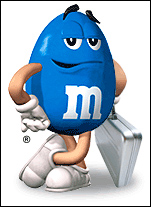Blue daba dee

Vorige week las ik ergens dat de blauwe M&M zeer binnenkort van de aardbol zou verdwijnen. Deze is namelijk de enige die niet gemaakt wordt met behulp van natuurlijke kleurstoffen. Dat deed me onmiddellijk terug denken aan volgende onderstaande internetklassieker (de man had trouwens gelijk toen ie het over de genetisch inferieure had):
Whenever I get a package of plain M&Ms, I make it my duty to continue the strength and robustness of the candy as a species. To this end, I hold M&Mduels. Taking two candies between my thumb and forefinger, I apply pressure, squeezing them together until one of them cracks and splinters. That is the "loser," and I eat the inferior one immediately. The winner gets to go another round.
I have found that, in general, the brown and red M&Ms are tougher, and the newer blue ones are genetically inferior. I have hypothesized that the blue M&Ms as a race cannot survive long in the intense theatre of competition that is the modern candy and snack-food world.
Occasionally I will get a mutation, a candy that is misshapen, or pointier, or flatter than the rest. Almost invariably this proves to be a weakness, but on very rare occasions it gives the candy extra strength. In this way, the species continues to adapt to its environment.
When I reach the end of the pack, I am left with one M&M, the strongest of the herd. Since it would make no sense to eat this one as well, I pack it neatly in an envelope and send it to M&M Mars, A Division of Mars, Inc., Hackettstown, NJ 17840-1503 U.S.A., along with a 3x5 card reading, "Please use this M&M for breeding purposes."
This week they wrote back to thank me, and sent me a coupon for a free 1/2 pound bag of plain M&Ms. I consider this "grant money." I have set aside the weekend for a grand tournament. From a field of hundreds, we will discover the True Champion. There can be only one.





<< Startpagina